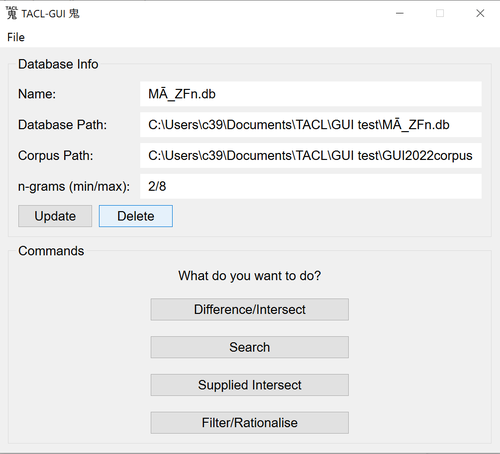This page gives all you need to download the TACL GUI, and run it for the purposes of research questions.

The TACL GUI is a GUI ("Graphic User Interface"), i.e. a point-and-click tool, that most users will find easier to run than "regular" TACL, which runs at the command line. The TACL GUI was created by Roland Borsos (PhD candidate, Heidelberg University) on an entirely voluntary basis. Roland Borsos runs a GitHub page, where users can get updates to the GUI, and also communicate with the programmer about technical problems with the GUI, or submit requests for improvements or changes.
You can get started with the GUI by downloading the TACL GUI starter kit. This is a zip file, which you first need to unzip using a tool like 7zip or WinZip.
The starter kit includes the following resources, some of which you can also access separately via the links provided:
Please note that the starter kit only includes the TACL GUI for PC/Windows. The GUI is also available for Linux and the Mac; those versions can be downloaded from the TACL GUI GitHub.
At Zenodo, we have also made available for download the following resources (described in more detail in the TALC GUI User's Manual).
Note the download sizes; download times could be long, especially for the database. Note also that these files, also, are zipped, and will need to be unzipped (see above).
NOTE: This corpus was modified and re-released in March 2023, to compensate for two problems in the CBETA XML discovered after the first release; those problems and the corresponding fixes are described in this document.
Blank (boilerplate) TACL catalogues for the Taishō-Xuzangjing corpus and the "Radich" Taishō corpus are available here.
In addition to these resources, users should also benefit from reading the TACL Methods Guide. By contrast to the TACL GUI User's Guide, which focuses on giving technical instructions to set up and run the software, the TACL Methods Guide aims to lay out principles for the effective and rigorous design of certain typical TACL tests from the point of view of content, that is, from the point of view of Buddhological and philological method.
As we explain in the User's Manual, the TACL GUI has been designed to be user-friendly and relatively simple to use. To that end, we have selected a sub-set of TACL functions for inclusion in the GUI, which are sufficient for work on certain typical types of research problem. Users who are interested in accessing the fuller range of TACL functions are encouraged to contact us, and/or to try "regular" TACL, as run from the command line.
Work on TACL and the TACL GUI has been supported by the Alexander von Humboldt Research Foundation, Victoria University of Wellington, Heidelberg University, and the Deutsche Forschungsgemeinschaft (DFG, project no. RA 3202/1-1). We gratefully acknowledge that support.